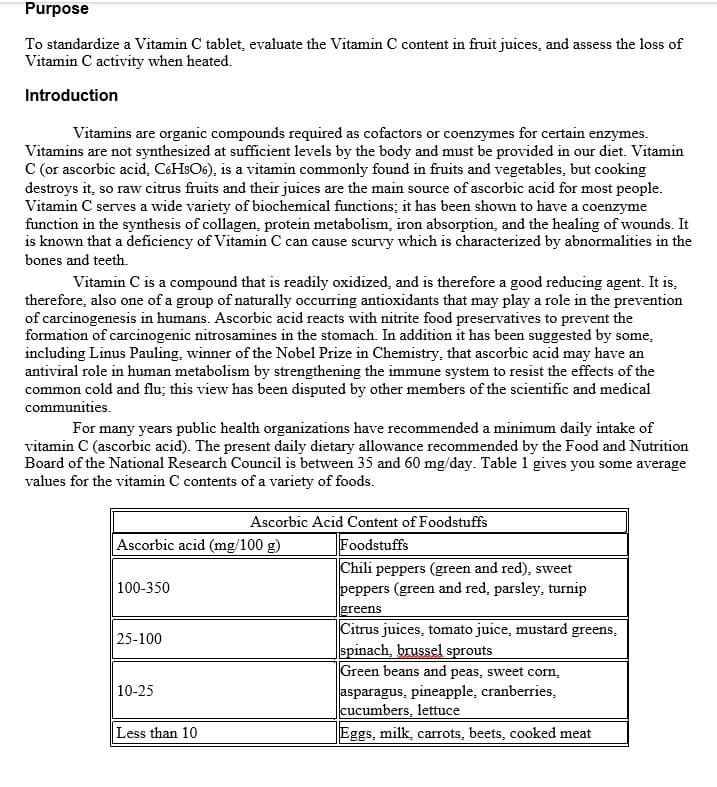Biochemistry
6th Edition
ISBN:9781305577206
Author:Reginald H. Garrett, Charles M. Grisham
Publisher:Reginald H. Garrett, Charles M. Grisham
Chapter25: Nitrogen Acquisition And Amino Acid Metabolism
Section: Chapter Questions
Problem 18P
Related questions
Question
- Describe a use for Vitamin C in foodstuffs.
The attached document below can be helpful

Transcribed Image Text:Purpose
To standardize a Vitamin C tablet, evaluate the Vitamin C content in fruit juices, and assess the loss of
Vitamin C activity when heated.
Introduction
Vitamins are organic compounds required as cofactors or coenzymes for certain enzymes.
Vitamins are not synthesized at sufficient levels by the body and must be provided in our diet. Vitamin
C (or ascorbic acid, C6HSO6), is a vitamin commonly found in fruits and vegetables, but cooking
destroys it, so raw citrus fruits and their juices are the main source of ascorbic acid for most people.
Vitamin C serves a wide variety of biochemical functions; it has been shown to have a coenzyme
function in the synthesis of collagen, protein metabolism, iron absorption, and the healing of wounds. It
is known that a deficiency of Vitamin C can cause scurvy which is characterized by abnormalities in the
bones and teeth.
Vitamin C is a compound that is readily oxidized, and is therefore a good reducing agent. It is,
therefore, also one of a group of naturally occurring antioxidants that may play a role in the prevention
of carcinogenesis in humans. Ascorbic acid reacts with nitrite food preservatives to prevent the
formation of carcinogenic nitrosamines in the stomach. In addition it has been suggested by some,
including Linus Pauling, winner of the Nobel Prize in Chemistry, that ascorbic acid may have an
antiviral role in human metabolism by strengthening the immune system to resist the effects of the
common cold and flu; this view has been disputed by other members of the scientific and medical
communities.
For many years public health organizations have recommended a minimum daily intake of
vitamin C (ascorbic acid). The present daily dietary allowance recommended by the Food and Nutrition
Board of the National Research Council is between 35 and 60 mg/day. Table 1 gives you some average
values for the vitamin C contents of a variety of foods.
Ascorbic Acid Content of Foodstuffs
Ascorbic acid (mg/100 g)
Foodstuffs
Chili peppers (green and red), sweet
peppers (green and red, parsley, turnip
100-350
greens
Citrus juices, tomato juice, mustard greens,
spinach, brussel sprouts
Green beans and peas, sweet corn,
asparagus, pineapple, cranberries,
cucumbers, lettuce
Eggs, milk, carrots, beets, cooked meat
25-100
10-25
Less than 10
Expert Solution
This question has been solved!
Explore an expertly crafted, step-by-step solution for a thorough understanding of key concepts.
Step by step
Solved in 2 steps

Knowledge Booster
Learn more about
Need a deep-dive on the concept behind this application? Look no further. Learn more about this topic, biology and related others by exploring similar questions and additional content below.Recommended textbooks for you

Biochemistry
Biochemistry
ISBN:
9781305577206
Author:
Reginald H. Garrett, Charles M. Grisham
Publisher:
Cengage Learning

Nutritional Sciences: From Fundamentals to Food, …
Health & Nutrition
ISBN:
9781337486415
Author:
McGuire
Publisher:
Cengage

Biology: The Dynamic Science (MindTap Course List)
Biology
ISBN:
9781305389892
Author:
Peter J. Russell, Paul E. Hertz, Beverly McMillan
Publisher:
Cengage Learning

Biochemistry
Biochemistry
ISBN:
9781305577206
Author:
Reginald H. Garrett, Charles M. Grisham
Publisher:
Cengage Learning

Nutritional Sciences: From Fundamentals to Food, …
Health & Nutrition
ISBN:
9781337486415
Author:
McGuire
Publisher:
Cengage

Biology: The Dynamic Science (MindTap Course List)
Biology
ISBN:
9781305389892
Author:
Peter J. Russell, Paul E. Hertz, Beverly McMillan
Publisher:
Cengage Learning

Health Safety And Nutrition F/Young Child
Health & Nutrition
ISBN:
9781305144767
Author:
MAROTZ
Publisher:
Cengage

Biology Today and Tomorrow without Physiology (Mi…
Biology
ISBN:
9781305117396
Author:
Cecie Starr, Christine Evers, Lisa Starr
Publisher:
Cengage Learning